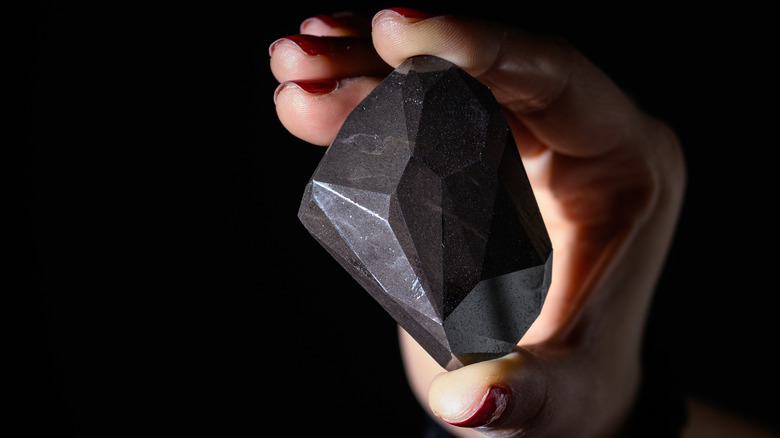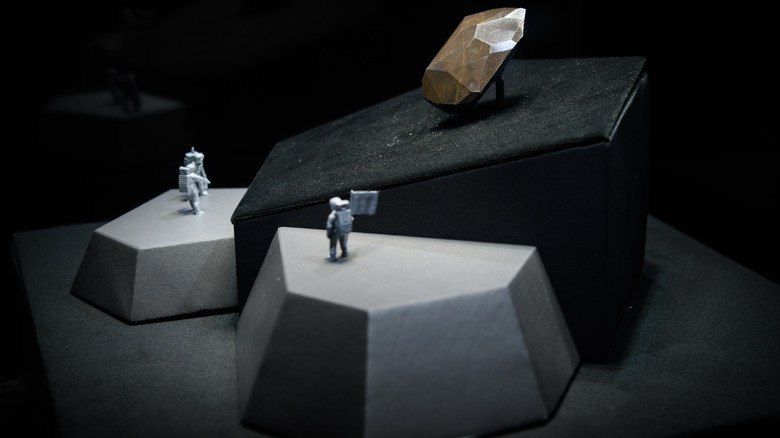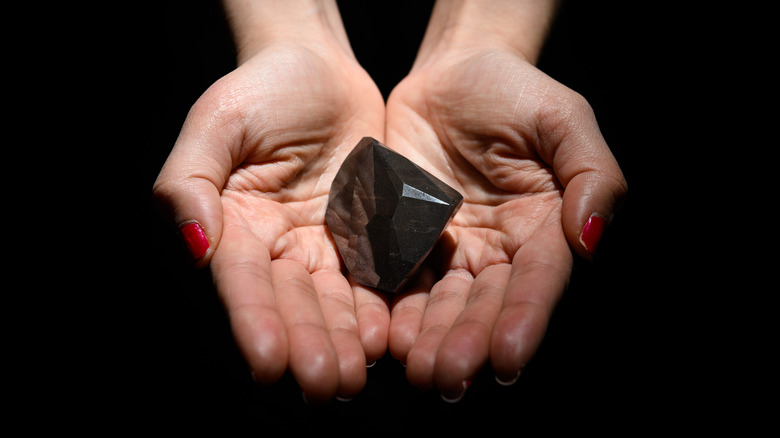The Unknown Origins Of The Mysterious Enigma Stone
For those with rings on their fingers, look down. How many karats is that thing? Wedding rings, engagement rings, just-for-fun rings: Gold, diamond, and other metals and minerals are often defined in terms of "karats." Typical for wedding bands is 14-karat gold, means 58.5% gold, as jewelers Golden Blessing explain. The rest is "additives" — copper, silver, nickel, etc. — that transform the metal into an alloy, a composite of different substances. What's termed 24-karat gold is 99.99% gold, which is actually worse for jewelry because gold is so soft.
For diamonds, karats (or "carats") work a bit differently. As Shining Diamonds explains, one carat equals 200 milligrams (one-fifth of a gram) of mineral. One of the biggest diamonds in recorded history, the Cullinan diamond, was discovered in South Africa in 1905, as British Heritage describes. In its uncut form it was 3,106 carats, or 0.62 kg — about 1.36 lbs. The diamond made its way to King Edward VII, where it was sliced up into nine main pieces. The biggest piece sets on the Sovereign's Sceptre and weighs 530.2 carats. The big diamond on the front of the Imperial State Crown weighs 317.4 carats. The whole, original Cullinan diamond sold for $194,000, which is about $6.2 million today (per the CPI Inflation Calculator).
But now? We've got a new heavyweight of champion of bejeweled luster. It's not your typical white diamond, but a 555.55-carat black diamond known as the Enigma. And as the name implies, no one knows where it came from.
A carbonado that's billions of years old
On February 10, 2022, as the BBC describes, an anonymous (and shall we say, enigmatic) online bidder became the new owner of the Enigma. The person, later identified as crypto-billionaire Richard Heart, paid $4.28 million in cryptocurrency, purchased at a sale held by U.K.-based auction house Sotheby's. Heart said he was planning on renaming the Enigma the "HEX.com diamond," after the blockchain currency he developed, "HEX."
And what exactly did Heart get for his bits of digital certification? Well, it's true that we know what the Enigma is made of. As National Geographic explains, it's what's called a black diamond, or a "carbonado," a type of mineral first discovered in the 1840s in eastern Brazilian mines. Carbonados get their name from the Portuguese word for carbonized (diamonds are made from pressurized, crystallized carbon), and to date, have only been found in Brazil and the Central African Republic. Black diamonds are extremely tough and harder to cut than white diamonds, and are generally cheaper because they're less popular as commodities, as Diamond Registry explains. Unlike white diamonds (which are actually colorless), black diamonds appear opaque because their crystalline structure prevents light from penetrating them.
The Enigma was found sometime before 1980, and sold anonymously in its original, uncut, 800-carat form. It took three years to carve it into its current, 55-facet polyhedral shape (at 555.55 carats, remember). As the Sotheby's website says, it holds the Guinness World Record as the largest cut diamond, outstripping the British monarchy's Cullinan diamond.
Born from meteorites or fossils
As for how the Enigma, or any carbonado, formed, the options boil down to, a) they came from space, or, b) they developed in Earth's mantle. Carbonados in Brazil and Central African Republic are basically the same, which means they existed since before Pangea, Earth's single supercontinent, started to separate 200 million years ago (via Live Science).
Earth itself is about 4.5 billion years old, as Space explains. Regular, white diamonds are anywhere from 900 million years old to 3 billion years old, as Selected Diamond state. Carbonados? If they came from space, they would've likely arrived here between 4 billion and 3.8 billion years ago, during our planet's infancy, per National Geographic. Carbonados don't contain traces of garnet and olivine like white diamonds, but "an exotic array of minerals" such as osbornite, a titanium nitride. Such minerals, while able to form in Earth's mantle, are rare. And yet, the Enigma — true to its name — is far too big for the usual size of meteorite that would have hit Earth back in the day.
One other, somewhat disturbing and/or wacky option, is that carbonados were formed from organic material. Life first formed on Earth about 3.7 billion years ago, as the Smithsonian explains. We're not talking big animals like us, but single-celled organisms. It's possible that a whole lot of these got sucked down into Earth's mantle, below the subduction zones (where the tectonic plates meet), and got compressed, and then fossilized, into black diamonds.


